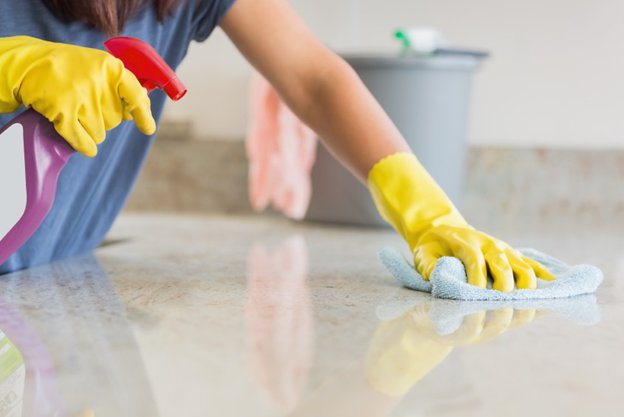Right now, many of us are locked down at home. While the condition is far from ideal, it may be a good time to clean up. We already knew, keeping a home clean is crucial in reducing the spread of COVID-19 (Coronavirus) and other germs. Besides, starting to clean up in the spring can help you feel productive and make your home a better place.
If anyone is sick in your house, it’s important not only to clean but also to disinfect surfaces. And your floors are no exception. Although you cannot consider the floor as a frequent point of contact, it is essential to keep these high-traffic areas as clean as possible. More importantly, if someone has walked around your house with shoes or if you have animals that could carry dirt and germs from the outside. While cleaning your surfaces and hard floors, don’t underestimate grout cleaning. Some germs might be there too. Follow the article to learn how to disinfect your house floor.
Cleaning Vs. Disinfecting: What’s the Difference?
Before learning to disinfect your house floor, you must be able to distinguish cleaning and disinfection. Cleaning should not be confused or used interchangeably with disinfection. The first means that you are wiping germs off but not killing them, while the second means that you are actually killing them. This distincting is essential to effectively clean surfaces. You might clean your floor, but it might not be disinfecting, leaving germs and bacteria to become infected and grow.
Disinfection, if done correctly, will kill microscopic organisms so they no longer can harm. The key areas to address are the areas shared by family members and those that come into close contact with bodily fluids. If your windows are dirty, they are not a big problem for your health, but you can touch a door handle after a sneeze. So, identify the areas that need to be disinfected.
Selecting a Disinfectant
Selecting a disinfectant a crucial first step to disinfect your house floor. Review the technical research bulletins provided by the providers. These bulletins will identify the various microorganisms against which the disinfectant has been tested.
Then combine the tested microorganisms with the most prevalent in your particular environment. In addition to the most common microorganisms, a disinfectant must have a wide range of destruction; it should be able to kill Gram-positive and Gram-negative bacteria, fungi, and viruses.
Second, calculate the parts per million (PPM) of active disinfectant. This calculation simply translates the percentage of active ingredients in parts per million. This calculation is % of active ingredients X 10000 Dilution rate.
The subsequent number can be used to determine the effectiveness of a hospital grade disinfectant when it introduces a load of dirt. when it introduces a load of dirt. When the employee cleans a floor and immerses the mop in the bucket of sanitizing solution, the solution degrades. At some point, around 300. At 350 ppm, a disinfectant will become ineffective. Therefore, it is recommended to change the dirty sanitizing solution regularly, usually every three to four pieces. Exceptions to this rule include solitary confinement, discharge, cleanup in surgery or delivery, and cleanup of blood spills.
How to Disinfect Hard Floors
Disinfect hard floors every day or every week after a quick sweep to make sure your unwanted guests (bacteria, germs, and fungi) are fired. You can also help prevent germs and troubles in your home by placing rugs in front of the doors and removing your shoes as soon as you enter the house.
When disinfecting wood floors, try to work in small sections to ensure that they can be rinsed quickly and effectively. Make the room well-ventilated while you are working. If you are not sure about whether a disinfectant is safe for your floors, test a small, less visible section of the floor before cleaning the entire area. And always read the label of the cleaning product before use to know how to disinfect correctly and follow the instructions for use.
Most hard surfaces suggest a bleach solution for disinfection. Still, you may often want to keep bleach and other harsh chemicals away from the ground. Instead, you can disinfect porcelain, vinyl and, laminate flooring by wiping it with a mixture of a gallon of hot water and a cup of vinegar. Then wipe off the germs from grout lines with a brush.
When disinfecting, be sure to wear disposable gloves if you have them on hand to protect your skin from chemicals. If you don’t have one-time gloves, dedicate your reusable gloves specifically to cleaning and disinfecting during the COVID-19. Carefully wash your hands as soon as you get rid of these gloves.
Take the necessary steps to reduce slips and falls on wet floors and clean floors when there is less traffic in your home to avoid injury. Make sure the floors have enough time to dry after cleaning and disinfection.
Also read : How to Start Interior Design – The Journey to Interior Design Is So Simple?
How to Disinfect Soft Floors
When it comes to disinfecting your house floors, soft surfaces like carpets and rugs can be a little more complicated than hard surfaces. The CDC recommends cleaning these surfaces with soap and water or with cleaners specially designed for these surfaces.
Besides, you need to pay attention to these cleansers and look for those that are made explicitly with disinfectant properties. If you have a carpet steam cleaner on hand, you can use it for more thorough cleaning. You can use this mixture of white vinegar with hot water in your spray bottle, but change the ratio each time.
In Conclusion
Frequent and thorough cleaning is important at this time to keep your home safe and healthy from the spread of coronaviruses and other diseases. The good news is that your routine floor cleaning, no matter what the surface of your floor, will usually be enough to reduce the spread of germs. Setting a daily schedule can help keep your home happy and healthy.




